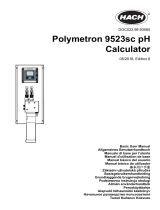Page is loading ...

HMD70U/Y Operating Manual M210277EN-C
1
HUMIDITY TRANSMITTER HMD70U
HUMIDITY AND TEMPERATURE TRANSMITTER HMD70Y
MOUNTING
Ø 12
(0.47)
250 (9.84)
62 (2.44)
<<< Mounting hole
82 (3.23)
100 (3.94)
>
>
>
100 (3.94)
82 (3.23)
Mounting
hole
Figure 1: Dimensions of the HMD70U/Y
The HMD70U/Y duct mounted humidity
and temperature transmitters are three-
wire transmitters. Mount the transmitter
with two screws. Place the drilling
template on the duct surface and drill the
holes as indicated. Remember to drill an
additional hole for calibration purposes.
The calibration can be conveniently
performed on site with the HMI41 or
HM70 indicator equipped with an
appropriate probe and optional
calibration cable.
GROUNDING
Open the lid and mount the cable bushing
set 18941HM. Ground the cable by
connecting the contact tongues inside the
bushing to an exposed length of cable
braid as shown in Figure 2. To minimize
short-circuit risk, do not expose more
cable braid than is necessary for
connecting the braid to the contact
tongues.
Figure 2: Signal cable grounding
*M210277EN*

HMD70U/Y Operating Manual M210277EN-C
2
ELECTRICAL CONNECTIONS AND INSTALLATION OF THE CURRENT MODULE
INSTALLATION OF
THE CURRENT MODULE 18945HM
1. Take off the jumpers
2. Connect the module; note the
right direction!
3. Connect the power supply
OUTPUT SELECTIONS
0...1V
0...5V
0...10V
0...20mA
current
module
T
RH
RH
RH
RH
T
T
T
T
RH
TEST
CONNECTOR
1
1
1
1
2 3
4
5
current module 0...20 mA
U
U
U
U
RH OFFSET
T OFFSET
Us
RH
out
T
out
GND
V/mA
DC/AC
power supply
V/mA
RH GAIN
T GAIN
Figure 3: Electrical connections and installation of the current module
CONNECTION TO AN AC SUPPLY
HMD70U/Y transmitter
Controller
VAC
VAC
Us
GND
signal
RH/T
GND
Us
RH/T
signal
HMD70U/Y transmitter
Figure 4: The recommended AC connection
HMD70U/Y transmitter
HMD70U/Y transmitter
Controller
shared
common line
VAC
GND
GND
Us
Us
RH/T
RH/T
signal
signal
Figure 5: A common loop formed in an AC
connection
The HMD70U/Y transmitters can also be
connected to an AC supply without an
external rectifier. However, when more
than one transmitter is connected to one
AC transformer, a common loop is
formed and there is an increased risk of a
short-circuit. To avoid this, use a
separate floating supply for each
transmitter (see Figure 4). However, if
several transmitters have to share one
transformer, the phase (~) must always
be connected to U
s
connector in each
transmitter (see Figure 5).

HMD70U/Y Operating Manual M210277EN-C
3
10528HM
18941HM
Glands
Lid
Screw terminal
Screws
Membrane filter
part no. 17039HM
Spare part sensor
part no. 15778HM
Stainless steel
sintered filter
part no. HM46670
TO REMOVE THE SENSOR HEAD:
1. Open the lid.
2. Disconnect the screw terminal.
3. Open the screws (2 pcs).
4. Pull out carefully.
TO REINSTALL THE SENSOR HEAD:
1. Push in the sensor head.
2. Fasten the screws.
3. Connect the screw terminal.
4. Close the lid.
Figure 6: Electronics (can be disconnected), accessories and spare parts
ONE-POINT RH CALIBRATION
The accuracy is recommended to be
checked at least once a year; the interval
depends on the operating conditions and
the required accuracy of the
measurement. When checking the
transmitter calibration, use the HMI41
indicator provided with an appropriate
probe and optional calibration cable. If
adjustment is necessary, use the humidity
offset potentiometer. If you prefer to
calibrate the HMD70U/Y transmitters
against saturated salt solutions, use LiCl
(11 %RH) and NaCl (75 %RH) solutions.
REPLACEMENT OF THE HUMICAP
SENSOR AND THE FILTER
Remove the damaged sensor and insert a
new one. Recalibrate the transmitter.
Replace a dirty filter (membrane or
sintered) to ensure a maximum lifetime
and a fast response time for the sensor.
Do not attempt to clean the filter.

HMD70U/Y Operating Manual M210277EN-C
4
TECHNICAL DATA
Relative humidity
Measurement range 0...100 %RH
Accuracy at 20 °C
Temperature dependence
Response time (90%)
at +20 °C in still air 15 s with membrane
filter
Humidity sensor INTERCAP 15778HM
Temperature (Y model only)
Measurement range -20...+80 °C
Accuracy
Linearity better than 0.1 °C
Temperature sensor Pt 1000 IEC 751class B
General
Supply voltage range depends on the selected output
signal. When AC supply is used, an isolated source is
recommended. The current outputs require an
optional output module, part no. 18945HM.
DC AC
0...1 V 10...35 V 9...24 V
0...5 V 14...35 V 12...24 V
0...10 V 19...35 V 16...24 V
0...20 mA (R
L
= 0 Ω) 10...35 V 11...24 V
0...20 mA (R
L
= 500 Ω) 20...35 V 17...24 V
Factory setting 0...1V. Other outputs selectable by
jumper connections. An output change causes an error
which is less than 0.5 %RH without recalibration.
Operating temperature range:
electronics -5...+55 °C
sensor head -40...+80 °C
Storage temperature range -40...+80 °C
Housing:
sensor head stainless steel
electronics housing cast aluminium
Cable glands
bushing for 7...10 mm (PG9)
cable (housing IP65/
NEMA 4),
part no 18941HM
or armoured cable glands part no 10528HM
Sensor protection:
standard membrane filter
(part no. DRW010525)
option stainless steel sintered
filter
(part no. HM46670)
Connections screw terminals
0.5...1.5 mm
2
Electromagnetic compatibility
The emission and immunity tests have been
performed according to standard EN 61326-1:1997 +
Am 1:1998, Electrical equipment for measurement,
control and laboratory use- EMC requirements; Light
environment.
Emissions:
Test
Radiated interference CISPR16, class B
Immunity:
Test Setup according to
Electrostatic discharge EN/IEC 61000-4-2
Electrical fast transients EN/IEC 61000-4-4
RF-radiated fields EN/IEC 61000-4-3
*GSM-field immunity ENV50204:1995,
criteria A
(*additional test)
GUARANTEE
Vaisala issues a guarantee for the material and
workmanship of this product under normal operating
conditions for one year from the date of delivery.
Exceptional operating conditions, damage due to
careless handling or misapplication will void the
guarantee.
Vaisala Oyj
Vanha Nurmijärventie 21,
FI-01670Vantaa, Finland

HMD 0U/Y M21027 N-C
INTERCAP 15778HM
/




